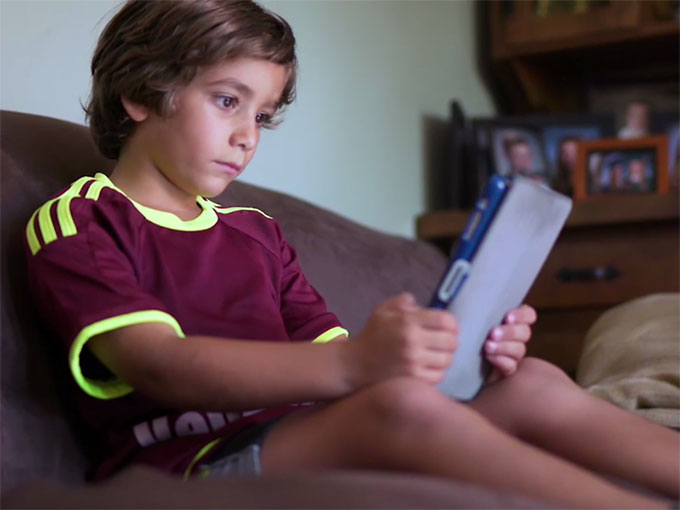A new study from Common Sense Media shows that the amount of screen usage among US kids is roughly the same as in prior years, but where children are spending their time has changed dramatically.
Building on similar research from 2011 and 2013, the newly released Common Sense Census: Media Use by Kids Age Zero to Eight reflects how kids’ relationship with media and technology has evolved. The 2017 study, which surveyed 1,454 US parents from high- and low-income families and diverse backgrounds, found that kids spend roughly two hours and 19 minutes with screen media each day.
While television remains at the top, commanding 58 minutes of kids’ attention per day, the report found that families with young children are now more likely to have a subscription video service like Netflix or Hulu (72%) than they are to have cable TV (65%).
Mobile activity, meanwhile, is rapidly gaining ground, rising to 48 minutes per day in 2017 (up from 15 minutes in 2013 and just five minutes in 2011). In fact, in 2017, mobile accounts for one third of all screen time (35%, compared to 4% in 2011). This increase is in line with the rise in homes reporting at least one mobile device (98% in 2017 compared to 75% in 2013 and 52% in 2011). Ninety-five percent of families with kids ages eight and under have smartphones, an increase over 2013 (63%) and 2011 (41%).
Tablets, meanwhile, were found in 78% of respondents’ homes (up from 41% in 2013 and 8% in 2011). Of those homes with tablets, 42% reported a tablet specifically for children eight and under, an increase over 7% in 2013 and less than 1% in 2011.
Interestingly, the research shows that screen media use among children under the age of two is down from 53 minutes per day in 2013 to 42 minutes per day in 2017. The descent is due mostly to a decline in viewing of DVDs, though this is partially offset by a slight increase in mobile device use among this age group. Common Sense, however, reports that this 16-minute difference is not statistically significant.
Another finding was that the digital divide has narrowed in recent years. Research found that 74% of lower-income families with children ages eight and under have high-speed internet service at home, compared with 96% of higher-income families. By contrast, only 42% of lower-income families had broadband access at home in 2011, versus 92% of higher-income families.
However, the research shows that children from lower-income homes spend an average of nearly two hours more time with screen media each day than those from higher-income homes (three hours and 29 minutes compared to one hour and 50 minutes). This difference in screen media use between lower- and higher-income families has been found in all three waves of the survey (2011, 2013 and 2017) but Common Sense reports that the gap has grown larger in 2017 due to television use going up in lower-income homes at the same time declining in higher-income homes.
In examining parents’ attitudes toward children’s media habits, the report found that Hispanic/Latino parents expressed the highest levels of concern about potential negative issues in media. For example, 54% of Hispanic/Latino parents compared to 38% of African-American parents and 28% of white parents identified as being “very” concerned about violence in the media.
Similarly, 43% of Hispanic/Latino parents strongly agreed that the less time kids spend with screen media the better, compared to 23% of white parents and 13% of African-American parents. African-American parents, meanwhile, were more likely to report that their child benefits from media use (83%) than Hispanic/Latino parents (77%) or white parents (72%). Top concerns for parents included violent content (78% reported being very or somewhat concerned), sexual content (77%), spending too much time with media (70%) and exposure to materialism and advertising (69%).
On average, the study found that kids ages eight and under spend approximately 30 minutes each day reading or being read to, an amount that has been steady since 2011. Electronic reading has not become popular among children, however, with only three of the 29 minutes spent reading each day dedicated to e-readers or tablets. And, despite the AAP’s recommendation that parents read to children “beginning in infancy,” the Common Sense report found that only 43% of children under the age of two are read to on a daily basis.
And while reading the old-fashioned way continues to be popular with kids, a number of high-tech trends were represented in the study. The report found that 11% of kids under the age of eight live in a home with a virtual reality headset, while 10% have internet-connected toys and 9% have a voice-activated virtual assistant or device in the home (such as Amazon Echo or Google Home).
In light of the new research, Common Sense is launching a series of PSAs featuring actor Will Ferrell (The Lego Movie) as part of its ongoing #DeviceFreeDinner campaign. The campaign challenges families to put down their devices during mealtimes and enjoy in-person conversation. The new PSAs were developed in partnership with the advertising agency Goodby Silverstein & Partners.
























